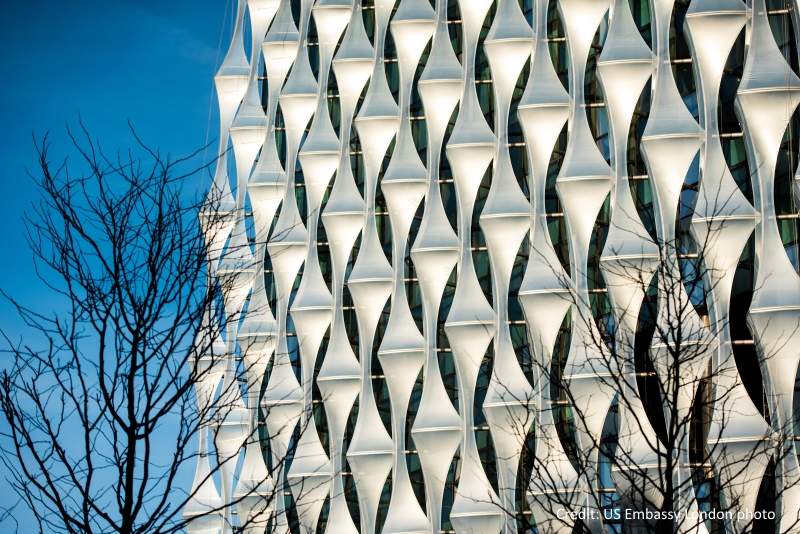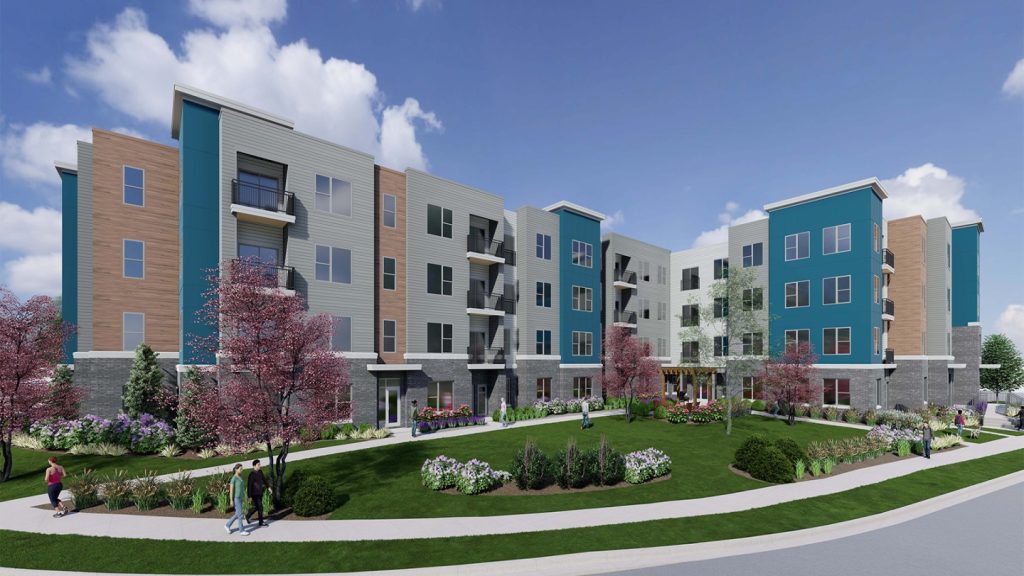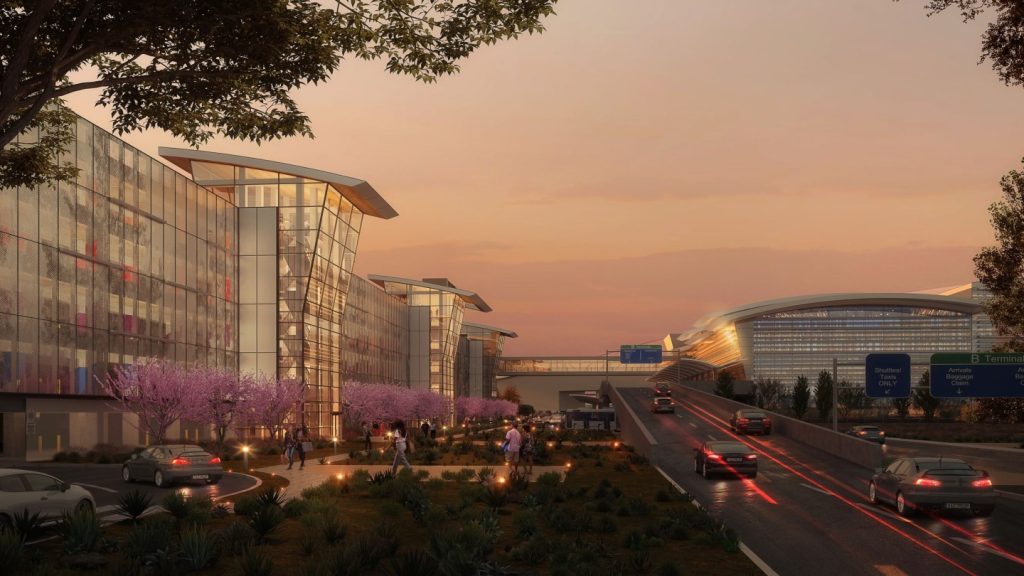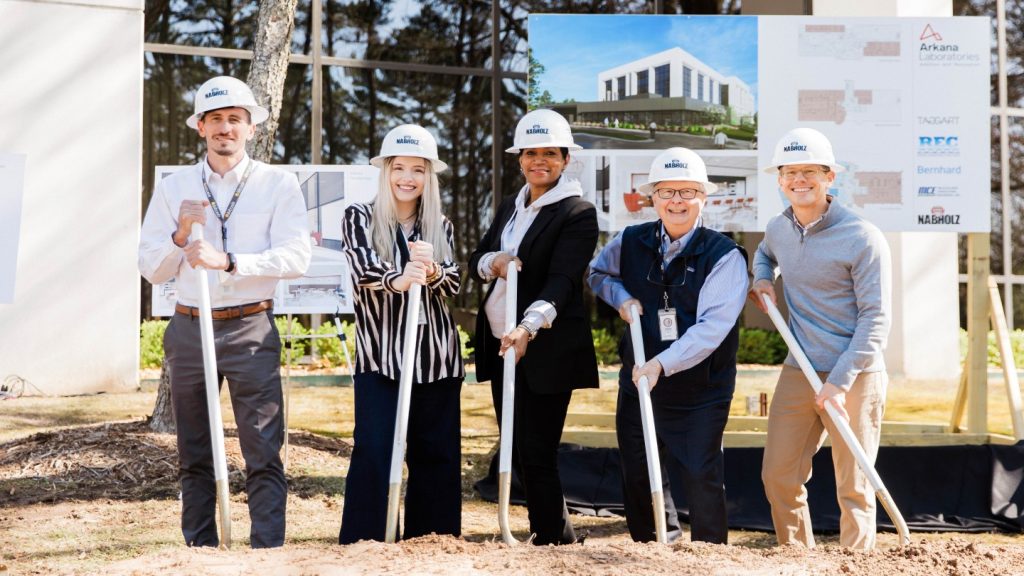
On Tuesday 16 January, the $1bn US embassy in London opened its doors to the public for the first time. The new building, a shimmering 12-storey glass cube designed by Philadelphia architecture firm KieranTimberlake, marks a number of changes for the US consulate in the UK.
Moving from a glamorous Grosvenor Square location, which has hosted US diplomats since John Adams in 1785 and sits across from the Italian embassy, to a former industrial district south of the River Thames called Nine Elms, the New London Embassy (NLE) represents a massive architectural as well as geographic departure.
The old embassy building, a modernist masterpiece complete with bald eagle centrepiece, was built in the late 1950s and designed by renowned Finnish-American architect Eero Saarinen. The NLE was designed to represent the best of modern American architecture, while balancing the environmental, operational and security concerns of a modern embassy.
The new embassy hasn’t been without criticism – when KieranTimberlake’s winning design was initially unveiled in 2010, there were reportedly dissenting voices even on the competition jury. The reception was similarly mixed when the NLE opened, with Daily Telegraph architecture critic Ellis Woodman deriding it as “a plastic-wrapped fortress in a dead part of London”, while The Guardian’s Rowan Moore praised the building’s efficiency and openness.

The original, Eero Saarinen-designed US embassy building in Grosvenor Square, Mayfair. The building is in a superb location and is much-loved for its architectural qualities, but practical concerns led to the decision in October 2008, under the Bush administration, to sell the building’s lease. The sale was completed at the end of 2009 for a reported $400m, although the exact sale price was never disclosed.
How well do you really know your competitors?
Access the most comprehensive Company Profiles on the market, powered by GlobalData. Save hours of research. Gain competitive edge.

Thank you!
Your download email will arrive shortly
Not ready to buy yet? Download a free sample
We are confident about the unique quality of our Company Profiles. However, we want you to make the most beneficial decision for your business, so we offer a free sample that you can download by submitting the below form
By GlobalDataThe main concern with the Grosvenor Square was security in a new age of terrorism, as it was deemed that there was not enough separation from the street to mitigate a bomb attack. “There were two narrow side streets by the embassy,” former US ambassador to the UK Bob Tuttle told the Washington Post in a January interview. “They are very slim, and if someone came down there with a truck, a la the Oklahoma City bombing, it would not only blow up half the embassy and kill half the people in it, but it would also kill half the people in nearby residences.”

The American flag is lowered for the last time during a ceremony at the Grosvenor Square embassy building on 9 January. In April 2016 it was announced by new owner, property developer Qatari Diar, that the embassy would be converted to a luxury hotel – revealed to be Rosewood Hotels & Resorts in September last year – as part of a wider £1bn restoration of Grosvenor Square.
“This is a major opportunity for London and a hotel of this exceptional calibre perfectly aligns with our vision and ambition to renew the heart of Mayfair,” said Qatari Diar chief development officer Sheikh Jassim Al-Thani in September.

An aerial photo showing the location (circled in blue) of the new embassy development, south of the River Thames. The Nine Elms area was chosen as it was one of the few remaining neighbourhoods of central London with enough available space to achieve the necessary security separation.
The embassy is intended to act as a hub for the Nine Elms Opportunity Area, a 450-acre plot that has been undergoing an extensive regeneration to bring in more commercial and residential infrastructure. In 2012, Wandsworth Council approved property development firm Ballymore’s plans for ‘Embassy Gardens’, an extensive mixed-use development that will wrap around the embassy complex.

One of KieranTimberlake’s design renders for the NLE. The glass structure’s cube shape was chosen for its timelessness, and three of the structure’s four sides feature high-performance ethylene tetrafluoroethylene plastic ‘sails’, which are designed to minimise solar gain and glare, stopping the building from overheating on sunny days. The structure embodies the principles of “transparency, openness and equality”, according to KieranTimberlake.

An illustration showing some of the NLE’s exterior characteristics. KieranTimberlake’s design shrewdly disguises a number of modern security features as natural landscape features. The scheme’s surrounding public provides separation from the street – modern US security guidelines for new embassy buildings require they be at least 100ft from neighbours – and the water feature is a moat deep enough to stop a truck attack. Elsewhere, security barriers and bollards are disguised as earthworks and hedgerows.
“All US embassies around the world are eventually going to conform to these security measures,” European Council on Foreign Relations research director Jeremy Shapiro told the Washington Post.

Steel framing being installed around the building’s core during construction in September 2014. At a cost of around $1bn, the NLE is reportedly the most expensive embassy ever built, although it comes at no cost to the American taxpayer. The project was funded entirely by the sale of the previous embassy, along with other London properties.

The NLE’s glass panels being installed in October 2015. The ultra-modern glass façade is intended to represent transparency, but at 15cm thick and rated as bomb-proof, it certainly conforms to the embassy’s security-conscious design brief. The plastic screens that are laid over the glass represent one of the more controversial elements of the scheme, but they serve to enhance the visual impact of the glass structure while mitigating solar glare, providing ample natural light and affording extensive views over the Thames.

Just three days after it was lowered for the last time at the Mayfair embassy, the US flag is raised for the first time at the NLE on 12 January. The building officially opened for business on 16 January. The embassy will house 800 staff and is set to receive around 1,000 visitors a day.

An interior garden in the NLE, designed to evoke the atmosphere of a Pacific forest. Internal garden spaces are present on every floor of the embassy, each referencing a different facet of the varied American landscape, from desert flowers and cacti to prairie wildflowers.
KieranTimberlake’s green approach goes deeper, with the NLE boasting some impressive environmental features. The roof of the building is covered in solar photovoltaic panels, while rainwater is collected for reuse in the moat and toilet systems. The embassy also incorporates ground-source heat pumps, combined heat and power, and demand-controlled ventilation. The architects expect the building to meet and surpass the highest sustainable design standards under the UK BREEAM (‘Outstanding’) and US LEED (‘Platinum’) environmental performance measures.

The new embassy’s large, airy lobby features a wall displaying the names of previous Ambassadors of the United States to the Court of St James’s, as they are formally known.

The NLE’s heat-mitigating plastic sails catch the sun in the late afternoon. The embassy’s designers, not to mention current US ambassador to the UK Robert Johnson, hope the building will help maintain and extend the ‘special relationship’ nurtured between the two countries.
“The new embassy is not just bigger, it is better and capable of meeting the complex challenges of the 21st century and beyond,” Johnson wrote in a guest editorial for the Evening Standard on 12 January. “Our new embassy reflects not just America’s special history with the UK but the special future ahead of us as we advance the prosperity and security of both our nations.”

Despite Ambassador Johnson’s optimistic words on the new embassy and what it means for US-UK relations, the building has been embroiled in something of an international diplomatic incident already. President Donald Trump, pictured here with UK Prime Minister Theresa May during her White House reception in January 2017, tweeted just before the NLE’s opening that he was cancelling his planned visit to London because “I am not a big fan of the Obama administration having sold perhaps the best located and finest embassy in London for ‘peanuts’, only to build a new one in an off location for 1.2 billion dollars.”
Only time will tell whether the new US embassy in London represents the “bad deal” that Trump paints it as, but there is little doubt that the new building is far more secure and environmentally sustainable than its modernist predecessor. Beyond that, the NLE’s success will likely be tied to the regeneration of the wider Nine Elms area, to which the US government has now hitched its $1bn consular cart.







